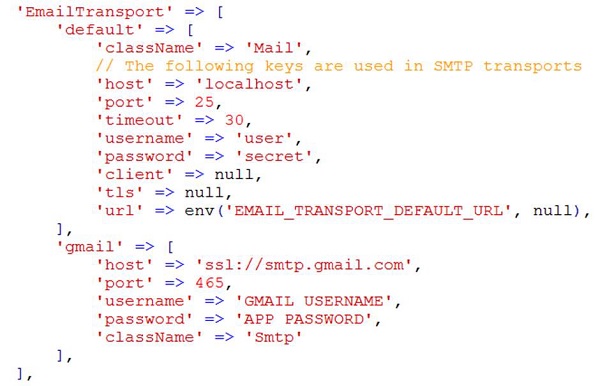
- CakePHP - Home
- CakePHP - Overview
- CakePHP - Installation
- CakePHP - Folder Structure
- CakePHP - Project Configuration
- CakePHP - Routing
- CakePHP - Controllers
- CakePHP - Views
- CakePHP - Extending Views
- CakePHP - View Elements
- CakePHP - View Events
- CakePHP - Working with Database
- CakePHP - View a Record
- CakePHP - Update a Record
- CakePHP - Delete a Record
- CakePHP - Services
- CakePHP - Errors & Exception Handling
- CakePHP - Logging
- CakePHP - Form Handling
- CakePHP - Internationalization
- CakePHP - Session Management
- CakePHP - Cookie Management
- CakePHP - Security
- CakePHP - Validation
- CakePHP - Creating Validators
- CakePHP - Pagination
- CakePHP - Date and Time
- CakePHP - File upload
- CakePHP Useful Resources
- CakePHP - Quick Guide
- CakePHP - Useful Resources
- CakePHP - Discussion
CakePHP - Internationalization
Like many other frameworks, CakePHP also supports Internationalization. We need to follow these steps to go from single language to multiple language.
Step 1
Create a separate locales directory resources\locales.
Step 2
Create subdirectory for each language, under the directory src\Locale. The name of the subdirectory can be two letter ISO code of the language or full locale name like en_US, fr_FR etc.
Step 3
Create separate default.po file under each language subdirectory. This file contains entry in the form of msgid and msgstr, as shown in the following program.
msgid "msg" msgstr "CakePHP Internationalization example."
Here, the msgid is the key which will be used in the View template file and msgstr is the value which stores the translation.
Step 4
In the View template file, we can use the above msgid, as shown below which will be translated based on the set value of locale.
<?php echo __('msg'); ?>
The default locale can be set in the config/app.php file by the following line.
'defaultLocale' => env('APP_DEFAULT_LOCALE', 'en_US')
To change the local at runtime, we can use the following lines.
use Cake\I18n\I18n;
I18n::locale('de_DE');
Example
Make changes in the config/routes.php file as shown in the following program.
config/routes.php
<?php
use Cake\Http\Middleware\CsrfProtectionMiddleware;
use Cake\Routing\Route\DashedRoute;
use Cake\Routing\RouteBuilder;
$routes->setRouteClass(DashedRoute::class);
$routes->scope('/', function (RouteBuilder $builder) {
$builder->registerMiddleware('csrf', new CsrfProtectionMiddleware([
'httpOnly' => true,
]));
$builder->applyMiddleware('csrf');
//$builder->connect('/pages',
['controller'=>'Pages','action'=>'display', 'home']);
$builder->connect('locale',
['controller'=>'Localizations','action'=>'index']);
$builder->fallbacks();
});
Create a LocalizationsController.php file at src/Controller/LocalizationsController.php. Copy the following code in the controller file.
src/Controller/LocalizationsController.php
<?php
namespace App\Controller;
use App\Controller\AppController;
use Cake\I18n\I18n;
class LocalizationsController extends AppController {
public function index() {
if($this->request->is('post')) {
$locale = $this->request->getData('locale');
I18n::setLocale($locale);
}
}
}
?>
Create a locales directory at resources\locales. Create 3 directories called en_US, fr_FR, de_DE under the locales directory. Create a file under each directory called default.po. Copy the following code in the respective file.
resources/locales/en_US/default.po
msgid "msg" msgstr "CakePHP Internationalization example."
resources/locales/fr_FR/default.po
msgid "msg" msgstr "Exemple CakePHP internationalisation."
resources/locales/de_DE/default.po
msgid "msg" msgstr "CakePHP Internationalisierung Beispiel."
Create a directory Localizations at src/Template and under that directory, create a View file called index.php. Copy the following code in that file.
src/Template/Localizations/index.php
<?php
echo $this->Form->create(NULL,array('url'=>'/locale'));
echo $this->Form->radio("locale",
[
['value'=>'en_US','text'=>'English'],
['value'=>'de_DE','text'=>'German'],
['value'=>'fr_FR','text'=>'French'],
]
);
echo $this->Form->button('Change Language');
echo $this->Form->end();
?>
<?php echo __('msg'); ?>
Execute the above example by visiting the following URL. http://localhost/cakephp4/locale
Output
Upon execution, you will receive the following output.

CakePHP provides Email class to manage email related functionalities. To use email functionality in any controller, we first need to load the Email class by writing the following line.
use Cake\Mailer\Email;
The Email class provides various useful methods which are described below.
| Syntax | From(string|array|null $email null, string|null $name null ) |
|---|---|
| Parameters |
|
| Returns | array|$this |
| Description | It specifies from which email address; the email will be sent |
| Syntax | To(string|array|null $emailnull, string|null $namenull) |
|---|---|
| Parameters |
|
| Returns | array|$this |
| Description | It specifies to whom the email will be sent |
| Syntax | Send(string|array|null $contentnull) |
|---|---|
| Parameters |
|
| Returns | array |
| Description | Send an email using the specified content, template and layout |
| Syntax | Subject(string|null $subjectnull) |
|---|---|
| Parameters |
|
| Returns | array|$this |
| Description | Get/Set Subject |
| Syntax | Attachments(string|array|null $attachmentsnull) |
|---|---|
| Parameters |
|
| Returns | array|$this |
| Description | Add attachments to the email message |
| Syntax | Bcc(string|array|null $emailnull, string|null $namenull) |
|---|---|
| Parameters |
|
| Returns | array|$this |
| Description | Bcc |
| Syntax | cc( string|array|null $emailnull , string|null $namenull ) |
|---|---|
| Parameters |
|
| Returns | array|$this |
| Description | Cc |
Example
Make changes in the config/routes.php file as shown in the following program.
config/routes.php
<?php
use Cake\Http\Middleware\CsrfProtectionMiddleware;
use Cake\Routing\Route\DashedRoute;
use Cake\Routing\RouteBuilder;
$routes->setRouteClass(DashedRoute::class);
$routes->scope('/', function (RouteBuilder $builder) {
$builder->registerMiddleware('csrf', new CsrfProtectionMiddleware([
'httpOnly' => true,
]));
$builder->applyMiddleware('csrf');
//$builder->connect('/pages',['controller'=>'Pages','action'=>'display', 'home']);
$builder->connect('/email',['controller'=>'Emails','action'=>'index']);
$builder->fallbacks();
});
Create an EmailsController.php file at src/Controller/EmailsController.php. Copy the following code in the controller file.
src/Controller/EmailsController.php
<?php
namespace App\Controller;
use App\Controller\AppController;
use Cake\Mailer\Email;
class EmailsController extends AppController{
public function index(){
$email = new Email('default');
$email->to('abc@gmail.com')
->subject('About')
->send('My message');
}
}
?>
Create a directory Emails at src/Template and under that directory, create a View file called index.php. Copy the following code in that file.
src/Template/Emails/index.php
Email Sent.
Before we send any email, we need to configure it. In the below screenshot, you can see that there are two transports, default and Gmail. We have used Gmail transport.
You need to replace the GMAIL USERNAME with your Gmail username and APP PASSWORD with your applications password. You need to turn on 2-step verification in Gmail and create a new APP password to send email.
config/app.php

Execute the above example by visiting the following URL − http://localhost/cakephp/email
Output
Upon execution, you will receive the following output.
